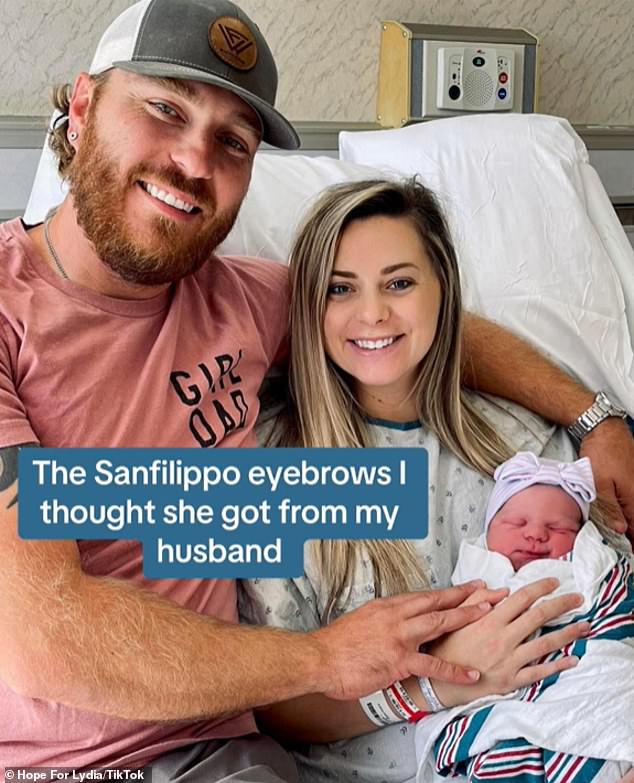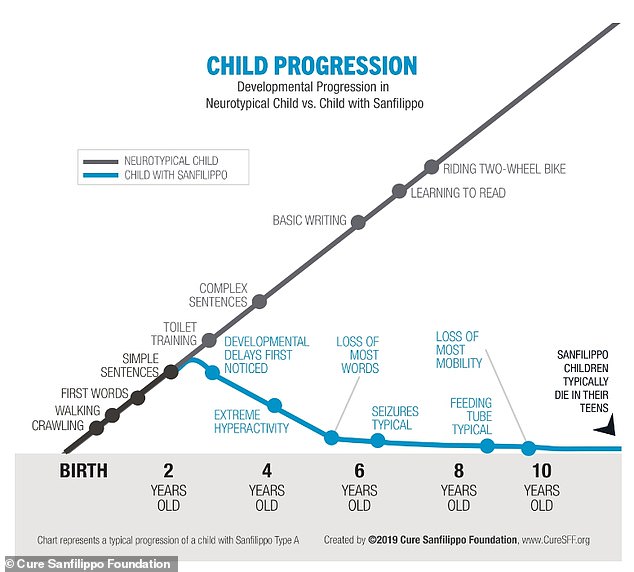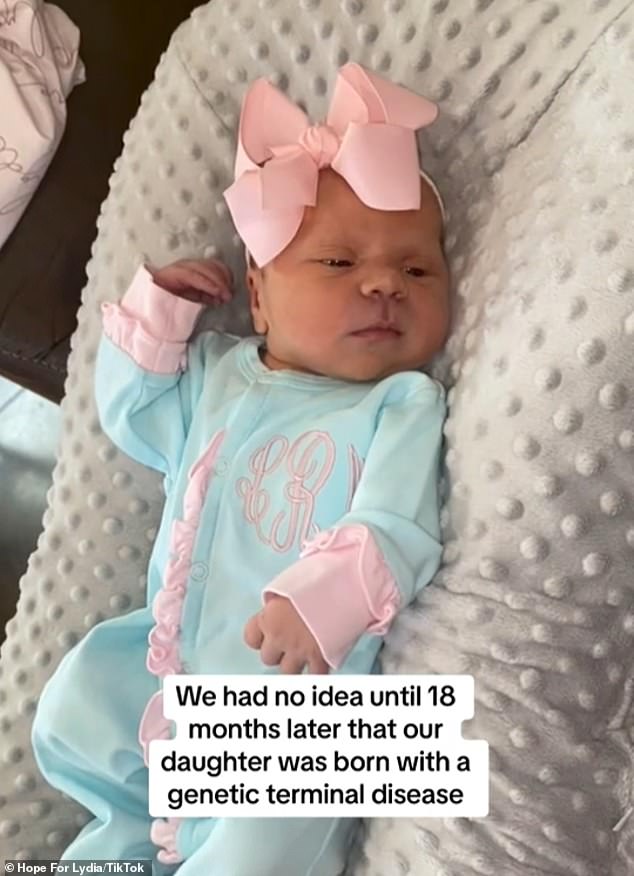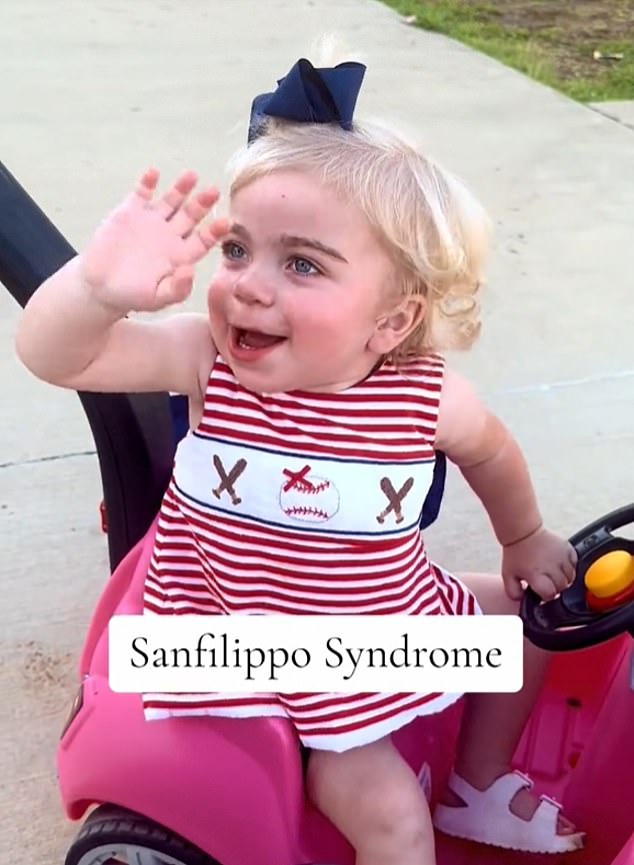I thought my little girl got her bushy eyebrows from her dad…which turned out to be an early sign of a heartbreaking disease
A Louisiana woman credits her “maternal instincts” for diagnosing her toddler with devastating “infantile dementia.”
When Morgan Rachal’s second daughter, Lydia, was born in October 2022, she noticed that the newborn had defined eyebrows that thickened over the following months.
Because people said Lydia “looked just like her father,” Mrs. Rachal didn’t think much about this unusual trait.
That is until her mother sent her a TikTok of a little girl with the rare disease Sanfilippo Syndrome who looked extremely similar to her daughter.
Ms Rachal said: ‘I looked at it and I just saw Lydia’s face in this child.’
At 18 months old, Lydia was diagnosed with Sanfilippo syndrome, a rare genetic condition that causes cognitive decline in children

When Lydia was born in October 2022, her mother noticed that the newborn had defined eyebrows that thickened over the following months, which the nurse attributed to an inherited trait from her husband, Kirk Rachal.

Ms Rachal said Lydia and her older sister Heidi are “best friends”.
Based on her instincts, the emergency room nurse urged doctors to genetically test Lydia in March.
When she was 18 months old, she was diagnosed with the genetic disease, which affects only 5,000 Americans and causes dementia-like symptoms in children, including the inability to talk, walk, eat independently or remember the skills they learn. learned all the time. their life.
It affects about one in 70,000 births each year and occurs when each parent passes on a defective gene. Most patients begin to deteriorate around age four and do not live beyond their early teens.
A month after the diagnosis, Ms Rachal posted on Facebook: ‘Thirty days ago was the worst day of my life so far. Even though I still had her existence, my heart broke as if I had lost her.
“I just lost the life I planned for her. The dance recitals, her childhood, softball tournaments with her sister, prom, wedding, watching her become a mother.
“We all have a ‘what it should look like’ view of life. In reality, we never know when their health will change, or when God will decide to take them home.”
In addition to dealing with her own emotions and those of her husband, Kirk Rachal, she added, “One of the hardest days of my life will be when I have to tell my oldest daughter that her sister has a terminal illness.”
She described Lydia and her four-year-old sister Heidi as “best friends.”

The graph above shows the typical progression of a child with Sanfilippo syndrome type IIIA compared to that of a typical healthy child

Sanfilippo syndrome is often called childhood dementia or Alzheimer’s disease because of its neurological and cognitive effects on children.
Even though it affects so few children, a community of parents have formed support groups on social media sites like TikTok, hoping that sharing their children’s pain will help raise awareness.
It was this online community that led Ms. Rachal to force her doctor, who had never heard of Sanfilippo syndrome, to perform genetic testing.
Because she advocated for her daughter, genetic specialists in New Orleans were able to examine Lydia and tell the family that the toddler’s condition had been caught early and had not yet caused brain damage.
In people with Sanfilippo syndrome, they lack an enzyme that breaks down a waste product produced in the body, leading to their brains becoming “clogged with toxic amounts” of the material, according to the Cure Sanfilippo Foundation.
Signs and symptoms include the distinctive eyebrows that Ms. Rachal noted, as well as mild speech delay, hyperactivity, irritability, coarse and excessive hair growth, rough facial features, severe sleep problems, respiratory infections, ear infections, digestive problems and unsteady walking.
Ms Rachal said Lydia has had recurrent constipation, as well as multiple ear infections and sleep disorders, and still does not fully sleep through the night.
She said: ‘I never thought there was anything wrong with her before – she has achieved all her milestones. She regularly has ear infections, constipation problems and sleep disorders. But these are all normal things for babies.’
As toxicity levels build up in the brain, it can lead to seizures, movement problems and chronic pain, but because of the behavioral symptoms, Sanfilippo is often initially misdiagnosed as ADHD or autism.
Mrs. Rachal told me People: ‘It’s so rare that many mothers have told me that their child was first diagnosed with autism because that is how they present themselves.’

Ms Rachal chronicles the family’s journey with Lydia and works to raise awareness of the condition on TikTok

Although it affects fewer than 5,000 Americans, a community of parents have formed support groups on social media sites like TikTok, hoping that sharing their children’s pain will help raise awareness
There are four subtypes of the condition, depending on which enzyme is missing or broken. Across the world, MPS IIIA is the most common and accounts for more than half of cases.
According to the foundation, it is also considered the most serious disease, causing symptoms and death at a younger age.
Ms. Rachal told People that doctors diagnosed Lydia with MPS IIIB, a less common form that progresses more slowly than the others.
There is no cure for the disease, but the Sanfilippo Foundation said research and clinical trials on enzyme replacements are working on treatments that could potentially slow the progression of the disease and extend a patient’s life.
As of now, doctors are trying to treat and manage the symptoms associated with Sanfilippo.
However, this week, Ms. Rachal posted a Facebook update saying that the FDA had determined that a gene therapy treatment could be effective for Sanfilippo syndrome.
On Wednesday, it was announced that Ultragenyx Pharmaceutical would prepare to apply for approval for its Sanfilippo gene therapy by the end of 2024, after working with the FDA to get an expedited review of its potential treatment.
In an early trial, the biotech said it saw stability or gains in cognitive function in 16 of 17 participants who received the therapy.
In addition, a 2023 study funded by Orchard Therapeutics at Manchester University NHS Foundation Trust found that four out of five patients diagnosed with Sanfilippo continued to acquire cognitive skills comparable to development in healthy children after receiving an experimental gene therapy .
It is not known how much each therapy will cost, when and how it will be made available, or whether health insurance will cover it.
